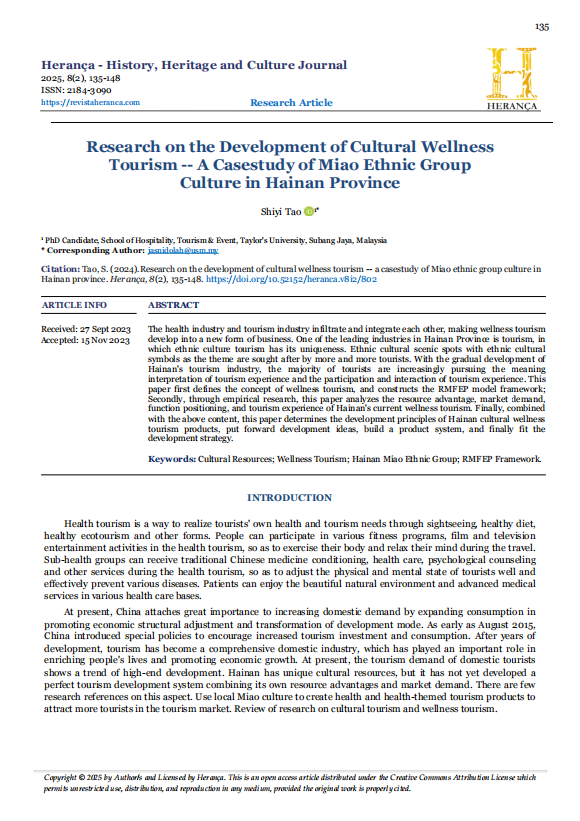Research on the Development of Cultural Wellness Tourism -- A Casestudy of Miao Ethnic Group Culture in Hainan Province
Keywords:
Cultural Resources, Wellness Tourism, Hainan Miao Ethnic Group, RMFEP FrameworkAbstract
The health industry and tourism industry infiltrate and integrate each other, making wellness tourism develop into a new form of business. One of the leading industries in Hainan Province is tourism, in which ethnic culture tourism has its uniqueness. Ethnic cultural scenic spots with ethnic cultural symbols as the theme are sought after by more and more tourists. With the gradual development of Hainan's tourism industry, the majority of tourists are increasingly pursuing the meaning interpretation of tourism experience and the participation and interaction of tourism experience. This paper first defines the concept of wellness tourism, and constructs the RMFEP model framework; Secondly, through empirical research, this paper analyzes the resource advantage, market demand, function positioning, and tourism experience of Hainan's current wellness tourism. Finally, combined with the above content, this paper determines the development principles of Hainan cultural wellness tourism products, put forward development ideas, build a product system, and finally fit the development strategy.
Downloads
References
Bentley, T., Meyer, D., Page, S., & Chalmers, D. (2001). Recreational tourism injuries among visitors to New Zealand: an exploratory analysis using hospital discharge data. Tourism Management, 22(4), 373-381.
Bowers, J. (2016). Developing sustainable tourism through eco museology: a case study in the Rupununi region of Guyana. Journal of Sustainable Tourism, 24(5), 758-782.
Department of Ethnic and Religious Affairs of Hainan Province. (1997). Hainan Miaozu renmin [The Miao ethnic group people in Hainan]. Haikou: Hainan Publishing House.
Didaskalou, E. A., & Nastos, P. (2003). The role of climatic and bioclimatic conditions in the development of ollness tourism products. Anatolia, 14(2), 107-126.
Du Cros, H., & McKercher, B. (2020). Cultural tourism. Abingdon, UK: Routledge.
Exhibition Hall of Ethnic Relics, South-Central University for Nationalities. (1957). Hainan Miaozu qingkuang diaocha [Investigation of the Miao ethnic group in Hainan]. Exhibition Hall of Ethnic Relics, South-Central University for Nationalities, Wuhan, China.
Ferrer, J. G., Sanz, M. F., Ferrandis, E. D., McCabe, S., & García, J. S. (2016). Social tourism and healthy ageing. International Journal of Tourism Research, 18(4), 297-307.
Gao, Z. Q. (2017). Hainan Miaozu lishi [History of the Miao ethnic group in Hainan]. Haikou, China: Nanfang Publishing House.
Ghorbanzadeh, M. (2018). Rural tourism entrepreneurship survey with emphasis on eco-museum concept. Civil Engineering Journal, 4(6), 1403-1414.
Heung, V. C., & Kucukusta, D. (2013). Wellness tourism in China: Resources, development and marketing. International journal of tourism research, 15(4), 346-359.
Horodnic, I. A., Williams, C. C., Windebank, J., Zaiț, A., & Ciobanu, C. I. (2021). Explaining consumer motives to purchase in the informal economy. Plos one, 16(10), e0258686.
Hu, Y. L. (2010). Hainan Lizu he Miaozu de fengsu xiguan [Customs of Li and Miao ethnic groups in Hainan]. Haikou, China: Southern Publishing House.
Huang, Y. H., & Huang, I. C. (2008). Hainan Miaozu yanjiu [The study of the Miao ethnic group in Hainan]. Haikou, China: Nanfang Press.
Hunt, C. A., & Harbor, L. C. (2019). Pro-environmental tourism: Lessons from adventure, wellness, and eco-tourism (AWE) in Costa Rica. Journal of Outdoor Recreation and Tourism, 28.
Lacedelli, S. Z., Fazzi, F., Zanetti, C., & Pompanin, G. (2023). From "exhibition" To "laboratory": Rethinking curatorial practices through a digital experimental project. The case study of# Dolomitesmuseum-laboratory of stories. Herança-Journal of History, Heritage and Culture, 6(1), 199-224
Li, S. (2010). Hainan guoji lvyou dao shenru wenhua zhilv [Hainan International Tourism Island in-depth cultural tour]. Qingdao, China: Qingdao Publishing House.
Liu, J. (2008). Hainan lvyou wenhua [Hainan tourism culture]. Haikou, China: Hainan Publishing House.
McKercher, B., & Du Cros, H. (2003).Testing a cultural tourism typology. International journal of tourism research, 5(1), 45-58.
Mueller, H., & Kaufmann, E. L. (2001). Wellness tourism: Market analysis of a special wellness tourism segment and implications for the hotel industry. Journal of vacation marketing, 7(1), 5-17.
Pan, M, G., Gao, Z. Q., & Pan, X. G. (2014). Hainan Miaozu zhi [Record of Miao ethnic group in Hainan]. Kunming, China: Yunnan Nationalities Publishing House.
Richards, G. (2018). Cultural tourism: A review of recent research and trends. Journal of Hospitality and Tourism Management, 36, 12-21.
Silva, A. J. M., & dos Santos, R. A. N. (2022). Rethinking touristification as a long-term process: The impact of tourism on the Madeiran cuisine (19th-21st centuries). Herança-Journal of History, Heritage and Culture, 5(2), 199-255.
Smith, M., & Kelly, C. (2006). Wellness tourism. Tourism recreation research, 31(1), 1-4.
Taleghani, M., Largani, M. S., & Mousavian, S. J. (2011). The role of wellness tourism in the development process (concepts and applications). Australian Journal of Basic and Applied Sciences, 5(10), 544-550.
Zhou, H. (2010). Hainan guoji lvyou dao te se wenhua yanjiu [Study on characteristic culture of Hainan international tourism island]. Haikou, China: Nanhai Publishing Company.

Downloads
Published
How to Cite
Issue
Section
License
Copyright (c) 2025 Herança

This work is licensed under a Creative Commons Attribution 4.0 International License.






8.png)





